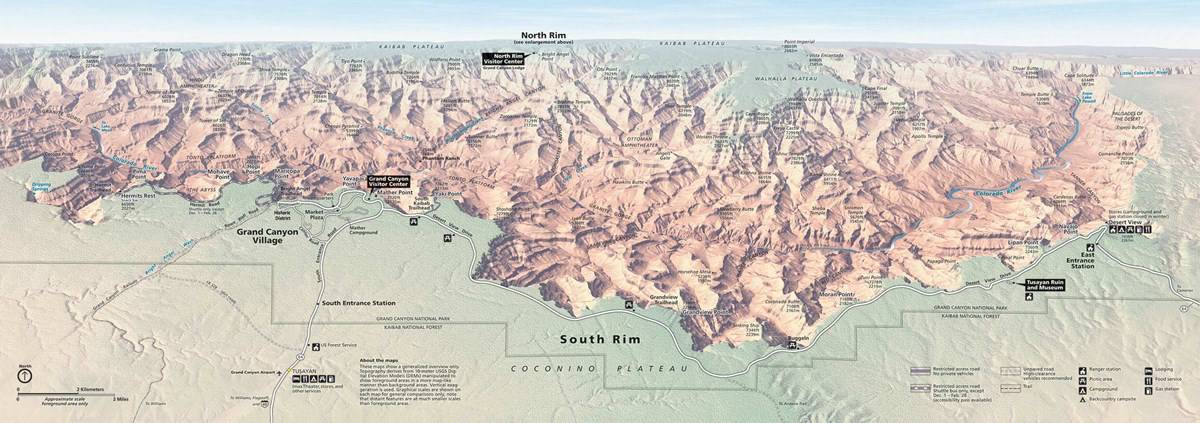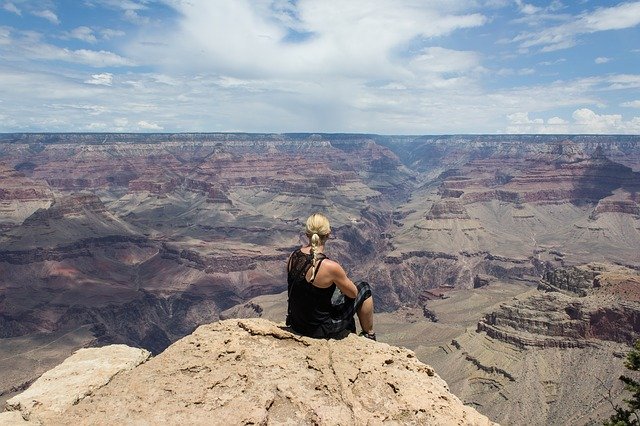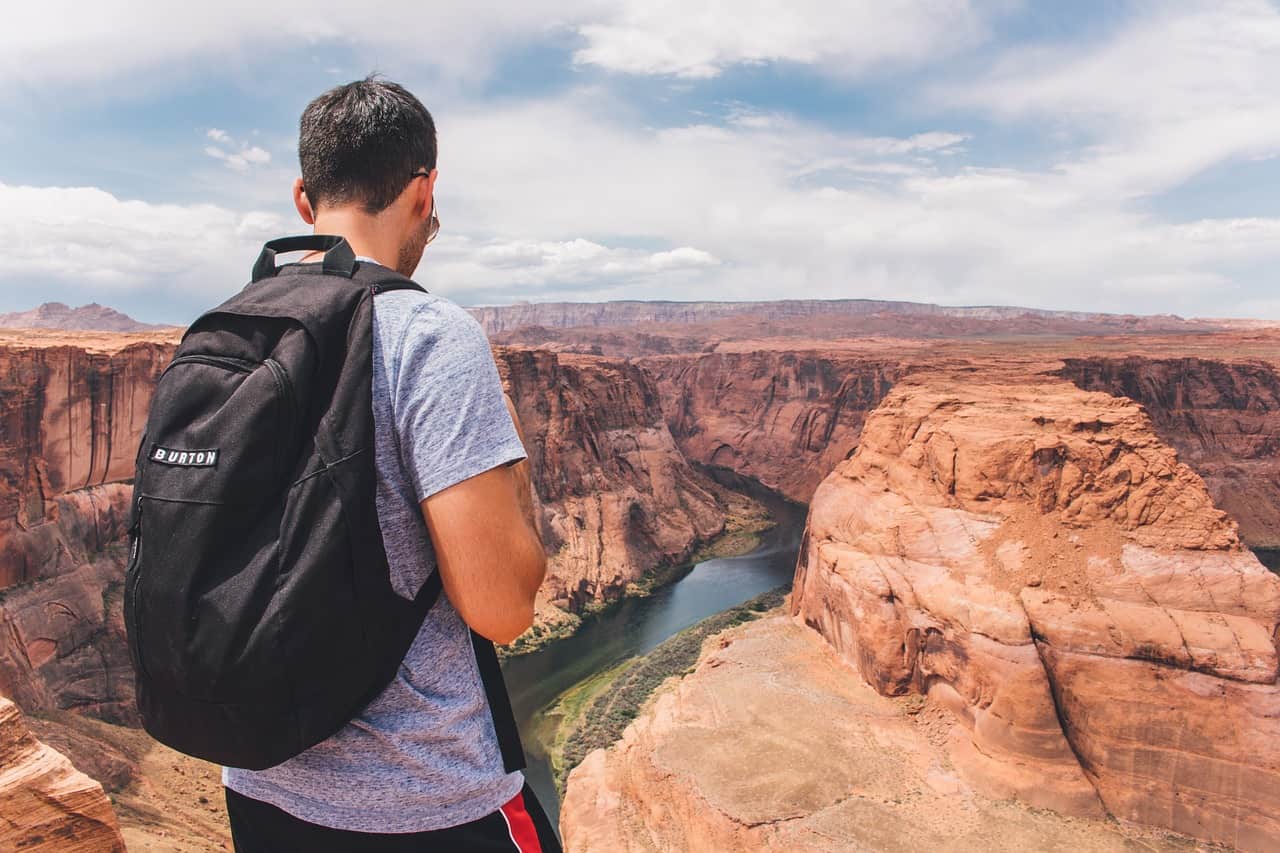The Grand Canyon National Park encompasses over 1.2 million acres of Arizona desert and has 54 different hard-packed trails, so it’s not uncommon for first-time or beginning hikers to ask the question, “Can You Hike the Grand Canyon without a Guide?“
The short answer is yes, you can absolutely hike the Grand Canyon without a guide and it’s a great way to save money, as many multi-day guided hiking tours at the Grand Canyon can easily cost thousands of dollars.
However, if you choose to hike the Grand Canyon without a guide, you’ll need to be completely self-reliant and in essence act as your own guide, by becoming familiar with the different areas of the park, the trails, and the dangers of hiking in the Grand Canyon.
Below we discuss all the things you need to know if you plan to hike the Grand Canyon without a guide, as well as provide some of the best information and resources available to help you with your planning and research for your solo hiking trip to the Grand Canyon.
What to Know if You Plan to Hike the Grand Canyon without a Guide
There are many things you need to know and be aware of if you plan to hike in or around the Grand Canyon without a guide, below we have listed some of the most important things that you must know before hiking in the Grand Canyon alone.
Know and Understand the Different Areas of the Grand Canyon

There are really four main areas of the Grand Canyon including the South Rim, the North Rim, Grand Canyon West, and Havasu Falls, however, only two of these areas are actually in the Grand Canyon National Park including the South and North Rim which we will be focussing on in this article.
South Rim
The South Rim at the Grand Canyon is by far the most crowded and popular area of the park, receiving 90% of the overall visitors to the park every year.
The area is accessed through two main entrances including the South Entrance and the East/Desert View Entrance. The South Entrance brings you right into the main area of the park including the South Rim Lodging, the visitor center, and popular restaurants. While the East/Desert View Entrance takes you to a more remote and quieter area of the South Rim.
Some of the most popular attractions and hiking trails at the Grand Canyon are located in the South Rim area including some amazing vantage points and vistas, the South Rim Trail, Bright Angel Trail, and South Kaibab Trail.
For even more information on the South Rim and all the things to do and see check out this super informative video on YouTube.
North Rim
The North Rim is by far the more remote and less-visited area of the Grand Canyon National Park and is only open from mid-May to mid-October.
The area only has one lodge called the Grand Canyon Lodge and one campground and both fill up quickly and often so if you plan to stay at either it’s important to make reservations as early as possible.
The North Rim is the area of the Grand Canyon that is closest to Utah and only has one main entrance that is about 30 miles south of Jacob Lake, Arizona. However, keep in mind when entering this entrance that you are still about 14 miles away from the actual North Rim as well as guest services.
While the South Rim area is certainly more popular and easier to get to compared to the North Rim, the North Rim still has plenty to do and see with some great trails that are worth checking out including the Grand Canyon scenic drive, Bright Angel Point Trail, Cape Final Trail, and many more.
Trails at the Grand Canyon
With 54 hard-packed trails at the Grand Canyon National Park, there is a trail for all types of hikers and skill levels, whether you are looking for a short easy walking trail or a rugged multi-day hike down into the canyon.
In general, Grand Canyon trails are well marked and not hard to follow but that doesn’t mean you don’t need a good map of the trail and area you plan to hike especially when hiking without a guide.
In most cases when hiking in and around the Grand Canyon the most difficult aspects of the hike and trails are the hot and dry conditions as well as the large elevation changes of the trails. And hiking with a guide really won’t help with either one of these challenges.
Top 5 Most Popular Trails in the Grand Canyon National Park
One of the most common things a hiking guide will help with while at the Grand Canyon is helping you to choose the best and most popular trails to hike while there.
However, you don’t need a guide for this information as all the best and most popular trails are easily and freely available on the National Park Service website and online.
And to help you get started we have included our top 5 list of the most popular and must-hike trails at the Grand Canyon.
South Rim Trail
The 13-mile paved South Rim Trail is a great place to start if you are new to the Grand Canyon as it offers some amazing views of the Grand Canyon. The trail also has minimal elevation change throughout the hike and offers numerous information placards to help you learn about the canyon, wildlife, and surrounding areas along the way.
Bright Angel Trail
The Bright Angel Trail is one of the most famous and iconic trails in the Grand Canyon National Park and a must for any hiker that wants to hike down into the Grand Canyon. The trail is approximately 9-miles long with over 4000 feet of elevation change from the South Rim to the Colorado River and is filled with spectacular views and nature throughout the hike.
South Kaibab Trail
In order to hike the South Kaibab Trail, you must use the shuttle system as no personal vehicles are allowed at the trailhead. But your extra effort in getting to the trail is more than rewarded as this trail is one of the most popular trails into the canyon. This 7-mile trail with almost 5000 feet of elevation change starts at the South Rim and goes all the way to the Colorado River.
North Kaibab Trail
The North Kaibab Trail is the only maintained trail that descends into the canyon from the North Rim.
This long 14-mile trail is filled with countless switchbacks and elevation changes, as it descends from the North Rim of the Grand Canyon all the way to the Colorado River.
Some main points of attraction to see along the trail, include the Supai Tunnel and the Roaring Springs, which is the source of all drinking water in the Grand Canyon Nation Park.
Cape Final Trail
If you’re looking for an easier trail that starts from the North Rim without as much elevation change as some of the trails that descend into the canyon, the Cape Final Trail is a great choice. As this 4-mile trail hikes along the North Rim to provide some amazing views and vistas with very little elevation change or crowds.

Dangers of Hiking at the Grand Canyon and What to Know if you Plan to Hike without a Guide
There are many dangers when hiking in the grand canyon, and if you plan to hike without the guidance or help of a guide it’s important to know how to mitigate these dangers while hiking alone in the Grand Canyon.
Heat
It’s important to remember when hiking and camping in the Grand Canyon that you will be hiking in a hot and arid desert climate that can be both unforgiving and punishing if you’re unprepared. Temperatures can reach well over 100 degrees in the canyon during the summer months and the sun can be relentless, heating up the trails and rocks until they both begin to radiate with heat.
So when hiking in the Grand Canyon it’s important that you bring plenty of water to keep yourself hydrated throughout the hike and know if and where the water sources are along the trail if they exist.
It’s also important to watch for any signs of heat stroke or dehydration, which can include but are not limited to rapid breath, racing heart rate, nausea, impaired mental state, headaches, or dizziness.
Elevation Change
Many trails at the Grand Canyon can have dramatic elevation changes that can exceed 5000 feet from the start of the trail to the end. And oftentimes many new or beginning hikers severely underestimate the amount of energy required to not only hike down into the canyon but especially back out.
So when hiking in the Grand Canyon make sure you are staying within your fitness level and not overdoing it when it comes to the trail and elevation change.
Remote and Desolate Land
Even though more than 5 million people visit the Grand Canyon every year and there are usually very large crowds at the main attractions, the Grand Canyon can be a very remote and desolate place while hiking along its trails.
In fact, if you choose to hike some of the longer and more remote trails at the canyon you can oftentimes be miles away from the next closest person. And because of this its important to be self-reliant and have a plan for emergencies when hiking at the Grand Canyon.
The Grand Canyon also encompasses more than 1.2 million acres of unpopulated and remote land and it can be very easy to get lost or turned around in some of the more remote and isolated areas of the park while hiking.
Because of this, it’s imperative that you stay on the trail while hiking in the Grand Canyon to not only prevent you from getting lost but also to make it easier to get help in case something were to go wrong while hiking in or around the canyon.
You might even want to consider carrying a compass to help keep your bearing while hiking as a backup to your trail map.
There is No Cell Phone Coverage Inside the Canyon
While you will more than likely have pretty good cell phone coverage near the main highways and around the main attractions, this is often not the case when you hike into the canyon. As cell phone coverage is very spotty if not completely non-existent when hiking inside the canyon so you will not be able to rely on your cell phone to provide you with information or maps while in the canyon.
Best Resources and Information for Planning Your Hiking Trip to the Grand Canyon without a Guide
There is a wealth of information on hiking in the Grand Canyon National Park and some of the best information is on the National Park Service website.
The National Park Service has trail descriptions of many of the most popular trails in the park with printable pdfs as well as information on hiking alerts and tips for hiking in the Grand Canyon on their website which you can check out by clicking here.
Some other great websites you should check out when researching and planning your hiking trip to the Grand Canyon include:
- AllTrails – This website has detailed information about most of the trails in the Grand Canyon with maps of the area.
- James Kaiser’s Grand Canyon Guide – The James Kaiser Grand Canyon guide is a very thorough and in-depth online guide to help plan your trip to the grand canyon.
- Dirt in My Shoes Website – This website has great basic information on the Grand Canyon and was created by a former park ranger named Ash.
- Top 20 Hiking Tips for the Grand Canyon – A great resource we created to help get your feet under you as a beginning or new hiker at the Grand Canyon.
If you’re looking for great information about hiking in the Grand Canyon that isn’t online then there are also several books you should check out including:
- Hiking Grand Canyon National Park by Ron Adkinson ((check the price on Amazon by clicking here))
- Grand Canyon: The Complete Guide: Grand Canyon National Park by James Kaiser ((check the price on Amazon by clicking here))
- Grand Canyon Trail Map 7th Edition by Sky Terrain and Kent Schulte ((check the price on Amazon by clicking here))
Can You Explore the Grand Canyon Without a Tour?
While professional tours and tour guides can be a wealth of information when exploring the Grand Canyon you do not need a tour to explore or visit the Grand Canyon.
In fact, when you enter the park you will usually be handed a small newspaper of information that has a map of the park as well as some basic information to help you navigate the park.
In addition, there is a visitor center on both the South Rim and North Rim that you can use to learn about the park and plan your trip. And finally, there are park rangers, especially at the main attractions and overlooks that can answer any questions you might have while visiting the park.
Is it Safe to Hike the Grand Canyon Alone?
While it’s safe to hike in and around the Grand Canyon without a tour guide or hiking guide, it’s not recommended or good hiking practice to hike completely by yourself while hiking at the Grand Canyon.
As there are many dangers and hazards at the Grand Canyon such as extreme heat, unforgiving and rugged landscapes, and large dropoffs and cliffs that can be especially dangerous when hiking the Grand Canyon alone, as there is no one to go and get help if you were to get hurt or become incapacitated while hiking.
So when hiking the Grand Canyon, always make sure to hike in at least pairs of two, as there is always safety in numbers.

